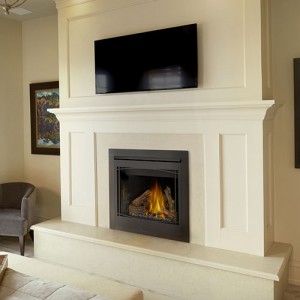 Fireplaces are one of the top amenities for homeowners who are looking to buy a new house. In fact, they only rank second behind outdoor patios, decks and porches. While the cost of adding a fireplace to an existing home used to be prohibitively expensive, today’s options are affordable, and they are also a relatively easy home improvement.
Fireplaces are one of the top amenities for homeowners who are looking to buy a new house. In fact, they only rank second behind outdoor patios, decks and porches. While the cost of adding a fireplace to an existing home used to be prohibitively expensive, today’s options are affordable, and they are also a relatively easy home improvement.
What has made adding a fireplace to a home easy and affordable is the technology and the installation flexibility of gas fireplaces. No actual combustion occurs in gas fireplaces, so zero-clearance installation is possible. This means that “these fireplaces can be installed in direct contact with combustible walls and floors. Their inner and outer shell construction allows for maximum heat insulation.” As long as you have a natural gas connection or propane availability, you can install a gas fireplace almost anywhere in your home. Shielded by tempered or ceramic glass, gas fireplaces can even be exposed on three or four sides.
The flexibility gas fireplaces, combined with a wide array of styles—from traditional to contemporary, a fire that looks and performs like real wood, and the benefit of improved energy efficiency, and gas fireplaces have become one of the hottest fireplace products today, outselling wood and pellet by more than half.
Benefits of gas over wood
Comparing prices, you’ll find little difference between gas and wood fireplaces, and installation costs are about equal as well. The main difference between gas and wood lies in venting and long-term performance.
The nice thing about gas is that you have immediate ignition and complete control over the heat output. With wood, a certain amount of time is required to light the fire, turn that energy into heat and then get that heat into a room.
In contrast to a gas fireplace, whose heat is controlled with a thermostat, a wood-burning fireplace only comes with air control—the damper.
High-end gas fireplaces are available with comfort control systems. These monitor the temperature of a room and start ramping the burner down as the room approaches a desired temperature.
What about the environment? “Wood is a renewable resource, gas isn’t.” In a gas fireplace there are very few by-products of combustion entering the atmosphere. So, environmentally, gas appliances can be considered healthier than a wood-burning appliance.
In next week’s blog, we’ll discuss venting options for gas fireplaces.
For more information, contact West Sport in Sudbury.
bobvila.com

Comments
{tag_commentlist}